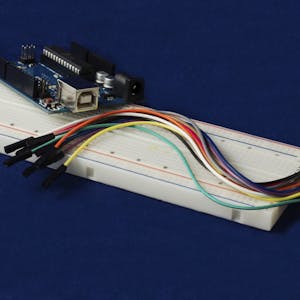The Arduino is an open-source computer hardware/software platform for building digital devices and interactive objects that can sense and control the physical world around them. In this class you will learn how the Arduino platform works in terms of the physical board and libraries and the IDE (integrated development environment). You will also learn about shields, which are smaller boards that plug into the main Arduino board to perform other functions such as sensing light, heat, GPS tracking, or providing a user interface display. The course will also cover programming the Arduino using C code and accessing the pins on the board via the software to control external devices. Please note that this course does not include discussion forums.Upon completing this course, you will be able to:
Outline the composition of the Arduino development board
Describe what it means to program the board's firmware
Read board schematics
Install Arduino IDE
Describe what "shields" are and how they are used
Specify the role of libraries in the use of shields
Compile and run a program
Name C Variables and Types
Name common C operators
Use conditionals and loops
Explain functions, their definition and invocation
Explain the implications of global variables
Undertake the Arduino build process
Describe the role of the tools behind the IDE
Describe how to invoke functions in classes
Explain the structure of an Arduino sketch
Access the pins of the Arduino
Differentiate between digital and analog pin
Debug embedded software
Explain the importance of controllability and observability in the debugging process
Describe common debugging architectures for embedded systems
Explain how the UART Serial communication protocol works
Describe how the Arduino Serial library performs serial communication
None
Syllabus
Syllabus - What you will learn from this course
Week 1
Arduino Environment
Week 2
C Programming
Week 3
Arduino Programs
Week 4
Module 4
This module provides an introduction to the Arduino environment which is composed of three things: the Arduino board, the Arduino IDE, and the Arduino-compatible shields together with their libraries. We first investigate the board, discussing all of its main components, inputs, and outputs. We discuss how each component is used and we examine the board schematic to see how they are connected. We then discuss the Arduino Integrated Development Environment (IDE) which is used primarily to write, compile, and upload code. We survey the interface of the IDE and discuss how to install and use it. We also examine the use of shields to extend the functionality of an Arduino-based system. We discuss how shield libraries provide a useful abstraction to facilitate programming.
FAQ
When will I have access to the lectures and assignments?
Access to lectures and assignments depends on your type of enrollment. If you take a course in audit mode, you will be able to see most course materials for free. To access graded assignments and to earn a Certificate, you will need to purchase the Certificate experience, during or after your audit. If you don't see the audit option:
The course may not offer an audit option. You can try a Free Trial instead, or apply for Financial Aid.
The course may offer 'Full Course, No Certificate' instead. This option lets you see all course materials, submit required assessments, and get a final grade. This also means that you will not be able to purchase a Certificate experience.
What will I get if I subscribe to this Specialization?
When you enroll in the course, you get access to all of the courses in the Specialization, and you earn a certificate when you complete the work. Your electronic Certificate will be added to your Accomplishments page - from there, you can print your Certificate or add it to your LinkedIn profile. If you only want to read and view the course content, you can audit the course for free.
Is financial aid available?
Yes. In select learning programs, you can apply for financial aid or a scholarship if you can’t afford the enrollment fee. If fin aid or scholarship is available for your learning program selection, you’ll find a link to apply on the description page.
Reviews
A very good course to teach you the basics of Arduino platform and IDE. It'll help you get started on how to code your programs and lets you build up on it. I'd definitely recommend for a beginner.
A very good course to give yourself a start in the world of embedded systems. The content is very focused, straight to the point and organized. I loved it and I would recommend it for you.
Nice course. The platform and programming is explained in a simple way. If you are already a C or C++ programmer, only the topics dealing with the Arduino platform will be important.
The course is great. It teaches in detail each and every aspect of arduino platform but it is very basic, it could be made more challenging as far as programming is concerned.
